
Richard Anthony Salisbury, FRS was a British botanist. While he carried out valuable work in horticultural and botanical sciences, several bitter disputes caused him to be ostracised by his contemporaries.
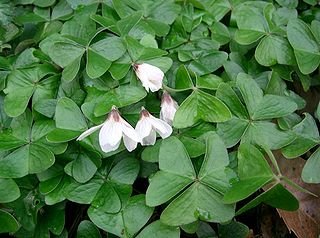
Oxalis or is a large genus of flowering plants in the wood-sorrel family Oxalidaceae, comprising about 570 species. The genus occurs throughout most of the world, except for the polar areas; species diversity is particularly rich in tropical Brazil, Mexico and South Africa.
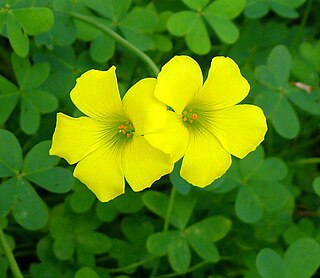
Oxalis pes-caprae is a species of tristylous flowering plant in the wood sorrel family Oxalidaceae. Oxalis cernua is a less common synonym for this species.

Banksia pulchella, commonly known as teasel banksia, is a species of small shrub that is endemic to the south-west of Western Australia. It has smooth grey bark, linear leaves and golden-brown flowers in short, cylindrical heads and inconspicuous follicles.
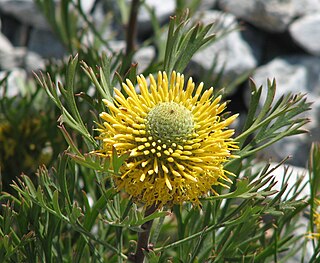
Isopogon anemonifolius, commonly known as broad-leaved drumsticks, is a shrub of the family Proteaceae that is native only to eastern New South Wales in Australia. It occurs naturally in woodland, open forest, and heathland on sandstone soils. I. anemonifolius usually ranges between one and two metres in height, and is generally smaller in exposed heathland. Its leaves are divided and narrow, though broader than those of the related Isopogon anethifolius, and have a purplish tinge during the cooler months. The yellow flowers appear during late spring or early summer and are displayed prominently. They are followed by round grey cones, which give the plant its common name drumsticks. The small hairy seeds are found in the old flower parts.
Perilampsis pulchella is a species of tephritid or fruit flies in the genus Perilampsis of the family Tephritidae.
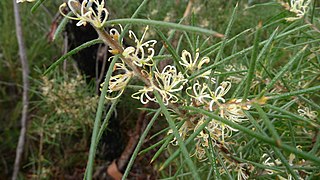
Hakea gibbosa, commonly known as hairy hakea or needlebush hakea, is a shrub of the family Proteaceae and is endemic to south eastern Australia. It has very prickly foliage, cream-yellowish flowers from April to July, and provides shelter for small birds. It has become an environmental weed in South Africa and New Zealand, where it had been introduced for use as a hedge plant.

Petrophile pulchella, commonly known as conesticks, is a common shrub of the family Proteaceae and is found in eastern Australia. The leaves are divided with needle-shaped but soft pinnae, the flowers silky-hairy, cream-coloured and arranged in oval heads and the fruit are arranged in oval heads. Conesticks grows on shallow sandstone soils, often in open forest or heathlands near the coast. It is also occasionally seen on the adjacent ranges.
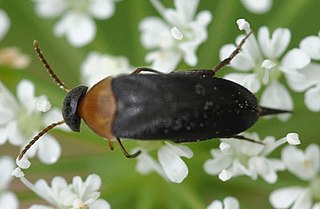
Mordellochroa is a genus of tumbling flower beetles in the family Mordellidae. There are about nine described species in Mordellochroa.

Oxalis articulata, known as pink-sorrel, pink wood sorrel, windowbox wood-sorrel, Chari amilo (Nepal),sourgrass,Netho (khatta) saag (India) is a perennial plant species in the genus Oxalis native to temperate South America. It has been introduced in Europe in gardens and is now naturalized in these areas.

The Paradisus Londonensis is a book dated 1805–1808, printed by D.N. Shury, and published by William Hooker. It consists of coloured illustrations of 117 plants drawn by William Hooker, with explanatory text by Richard Anthony Salisbury.

Protea burchellii, also known as Burchell's sugarbush, is a flowering shrub in the genus Protea, which is endemic to the southwestern Cape Region of South Africa.

Oxalis tenuifolia, also known by its common name thinleaf sorrel, is a species from the genus Oxalis. The plant was first described by Christian Friedrich Ecklon and Karl Ludwig Philipp Zeyher.
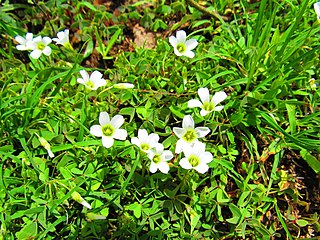
Oxalis alpina, also known by its common name alpine woodsorrel, is a species from the genus Oxalis.

Oxalis ambigua is a species from the subgenus Oxalis.
Leptusa pulchella is a species of beetle belonging to the family Staphylinidae.
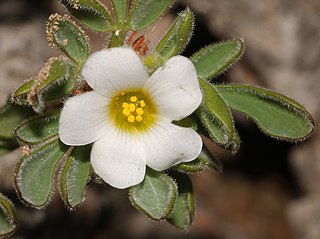
Oxalis virginea, commonly known as Virgin sorrel, is a species from the genus Oxalis. It is endemic to South Africa. O. virginea was first described by Nikolaus Joseph von Jacquin in 1798. This species is apparently lacking a type specimen.
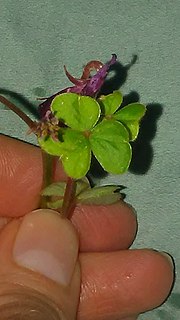
Oxalis brasiliensis, also known by its common name Brazilian woodsorrel is a species from the sectionIonoxalis. It was first described by Dámaso Antonio Larrañaga.
















